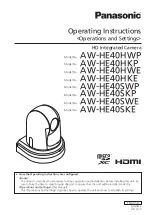
3
1 Safety Precaution
1.1.
General Guidelines
1.
IMPORTANT SAFETY NOTICE
There are special components used in this equipment
which are important for safety. These parts are marked by
in the Schematic Diagrams, Circuit Board Layout,
Exploded Views and Replacement Parts List. It is essen-
tial that these critical parts should be replaced with manu-
facturer’s specified parts to prevent X-RADIATION,
shock, fire, or other hazards. Do not modify the original
design without permission of manufacturer.
2. An Isolation Transformer should always be used during
the servicing of AC Adaptor whose chassis is not isolated
from the AC power line. Use a transformer of adequate
power rating as this protects the technician from acci-
dents resulting in personal injury from electrical shocks. It
will also protect AC Adaptor from being damaged by acci-
dental shorting that may occur during servicing.
3. When servicing, observe the original lead dress. If a short
circuit is found, replace all parts which have been over-
heated or damaged by the short circuit.
4. After servicing, see to it that all the protective devices
such as insulation barriers, insulation papers shields are
properly installed.
5. After servicing, make the following leakage current
checks to prevent the customer from being exposed to
shock hazards.
1.2.
Leakage Current Cold Check
1. Unplug the AC cord and connect a jumper between the
two prongs on the plug.
2. Measure the resistance value, with an ohmmeter,
between the jumpered AC plug and each exposed metal-
lic cabinet part on the equipment such as screwheads,
connectors, control shafts, etc. When the exposed metal-
lic part has a return path to the chassis, the reading
should be between 1 M
Ω
and 5.2 M
Ω
. When the exposed
metal does not have a return path to the chassis, the
reading must be infinity.
1.3.
Leakage Current Hot Check
(See Figure 1.)
1. Plug the AC cord directly into the AC outlet. Do not use
an isolation transformer for this check.
2. Connect a 1.5 k
Ω
, 10 W resistor, in parallel with a 0.15
μ
F
capacitor, between each exposed metallic part on the set
and a good earth ground, as shown in Figure 1.
3. Use an AC voltmeter, with 1 k
Ω
/V or more sensitivity, to
measure the potential across the resistor.
4. Check each exposed metallic part, and measure the volt-
age at each point.
5. Reverse the AC plug in the AC outlet and repeat each of
the above measurements.
6. The potential at any point should not exceed 0.75 V RMS.
A leakage current tester (Simpson Model 229 or equiva-
lent) may be used to make the hot checks, leakage cur-
rent must not exceed 1/2 mA. In case a measurement is
outside of the limits specified, there is a possibility of a
shock hazard, and the equipment should be repaired and
rechecked before it is returned to the customer.
Figure. 1
Содержание DMC FS7P - Lumix Digital Camera
Страница 15: ...15 4 Specifications ...
Страница 19: ...19 3 Error Code List The error code consists of 8 bits data and it shows the following information ...
Страница 23: ...23 8 Disassembly and Assembly Instructions 8 1 Disassembly Flow Chart 8 2 PCB Location ...
Страница 25: ...25 Fig D2 8 3 2 Removal of the LCD Unit Fig D3 ...
Страница 26: ...26 8 3 3 Removal of the Top Operation Unit Fig D4 8 3 4 Removal of the Flash Top P C B Fig D5 Fig D6 ...
Страница 27: ...27 Fig D7 8 3 5 Removal of the Lens Unit Fig D8 Fig D9 8 3 6 Removal of the Main P C B Fig D10 ...
Страница 28: ...28 8 3 7 Removal of the SD FPC Unit Fig D11 8 3 8 Removal of the Battery Case Unit Fig D12 Fig D13 ...
Страница 49: ...S7 2 Packing Parts and Accessories Section 1 S 14 224 210 229 226 225 200 201 202 208 204 205 206 215 214 207 ...




































